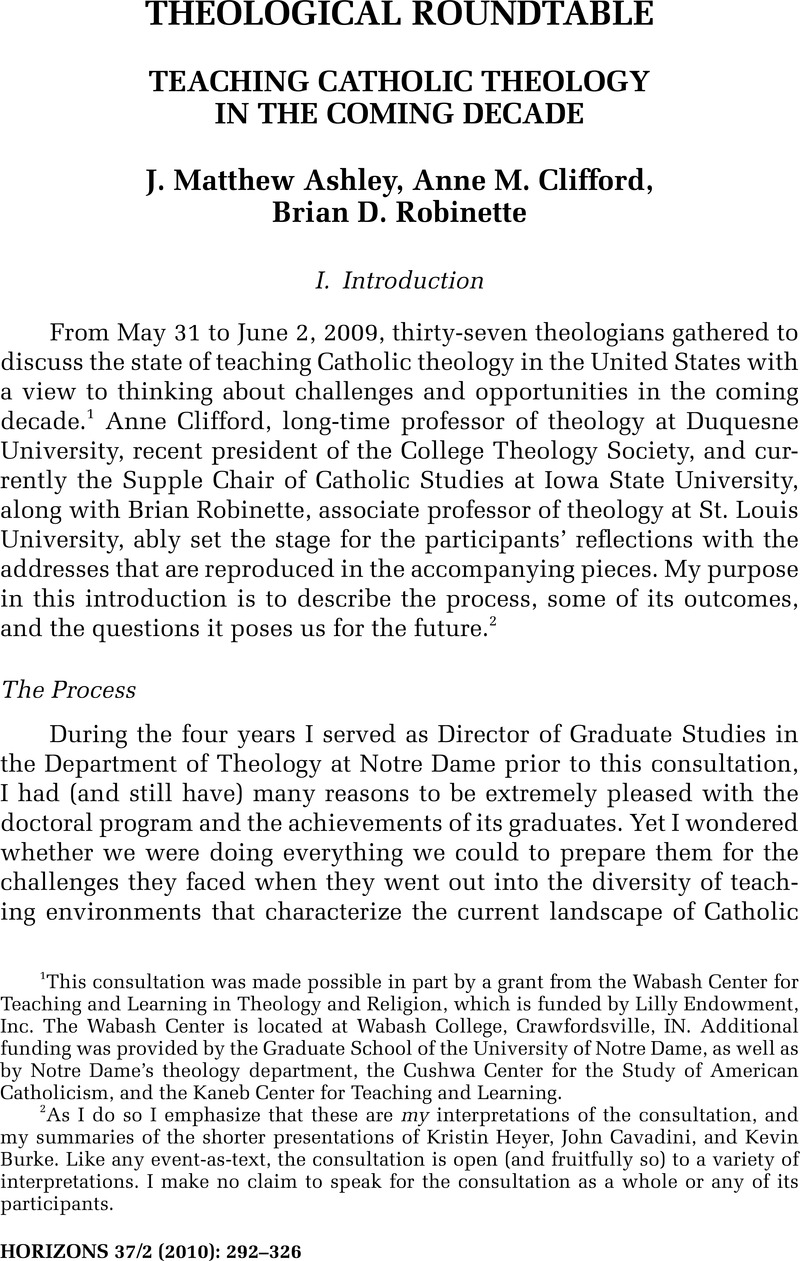No CrossRef data available.
Article contents
Teaching Catholic Theology in the Coming Decade - I. Introduction
Published online by Cambridge University Press: 18 March 2013
Abstract

- Type
- Theological Roundtable
- Information
- Copyright
- Copyright © The College Theology Society 2010
References
1 This consultation was made possible in part by a grant from the Wabash Center for Teaching and Learning in Theology and Religion, which is funded by Lilly Endowment, Inc. The Wabash Center is located at Wabash College, Crawfordsville, IN. Additional funding was provided by the Graduate School of the University of Notre Dame, as well as by Notre Dame's theology department, the Cushwa Center for the Study of American Catholicism, and the Kaneb Center for Teaching and Learning.
2 As I do so I emphasize that these are my interpretations of the consultation, and my summaries of the shorter presentations of Kristin Heyer, John Cavadini, and Kevin Burke. Like any event-as-text, the consultation is open (and fruitfully so) to a variety of interpretations. I make no claim to speak for the consultation as a whole or any of its participants.
3 We focused on departments of theology rather than religious studies, not because of any predisposition against the latter, but in order to remove the further variable of the relationship between the disciplines of theology and religious studies from the conversation.
4 Morey, Melanie and Piderit, John, Catholic Higher Education (New York: Oxford, 2006).CrossRefGoogle Scholar For a brief overview of these categories, see Anne Clifford's address.
5 The following institutions had participants in the consultation (in alphabetical order): Barry University(Miami Shores, FL); Boston College (Chestnut Hill, MA); The Catholic University of America (Washington, DC); College of the Holy Cross (Worcester, MA); College of Saint Catherine (St. Paul/Minneapolis, MN); Fairfield University (Fairfield, CT); Fordham University, (New York, NY); Franciscan University of Steubenville (Steubenville, OH); Gonzaga University (Spokane, WA); Iowa State University (Ames, IA); Jesuit School of Theology at Berkeley (Berkeley, CA); Lourdes College (Sylvania, OH); Loyola University of Chicago (Chicago, IL); Marquette University (Milwaukee, WI); Sacred Heart University (Fairfield, CT); Santa Clara University (Santa Clara, CA); St. John's University (Collegeville, MN); St. Louis University (St. Louis, MO); St. Mary's University (San Antonio, TX); Saint Mary's College of California (Moraga, CA); St. Thomas University (Miami Gardens, FL); St. Vincent College (Latrobe, PA); University of Dayton (Dayton, OH); University of Notre Dame (Notre Dame, IN); Villanova University (Villanova, PA); Xavier University of Louisiana (New Orleans, LA).
6 She drew, in particular, on the work of Rausch, Thomas, Being Catholic in a Culture of Choice (Collegeville, MN: The Liturgical Press, 2006)Google Scholar, with reference as well to Christian Smith, with Denton, Melinda Lundquist, Soul Searching: The Religious and Spiritual Lives of American Teenagers (New York: Oxford University Press, 2005).Google Scholar
7 See Portier, William, “Here Come the Evangelical Catholics,” Communio 31 (Spring 2004): 35–65.Google Scholar
8 This point was also made, in different words, by Clifford in her address.
9 For Tracy's discussion, see Tracy, David, The Analogical Imagination: Christian Theology and the Culture of Pluralism (New York: Crossroad, 1981), 3–31.Google Scholar
10 I note again that this is my summary of the presentation (as with the other two) and not a verbatim report or an abstract provided by the presenter.
11 I wish to express my thanks to all the consultation participants. They worked very hard for the two days of the consultation, and showed uncommon openness and charity to others, especially to those with whom they disagreed. The following individuals worked with the small groups and took careful and clear notes on the discussions: Elizabeth Antus, Thomas Bushlack, Kristin Colberg, James Lee, and Andrew Prevot. I am grateful to them as well. Finally, I take this opportunity to thank my assistant, and now colleague, Ernesto Valiente, without whose organizational skills and creativity this consultation could not have succeeded.




